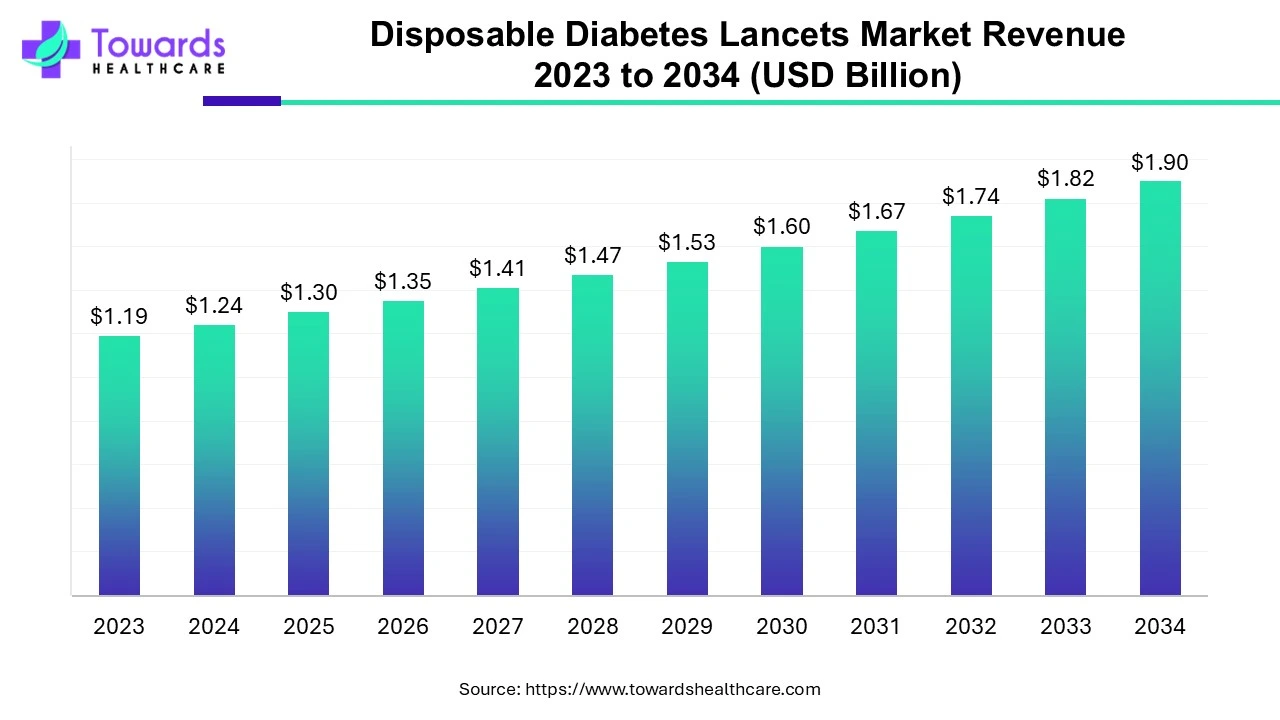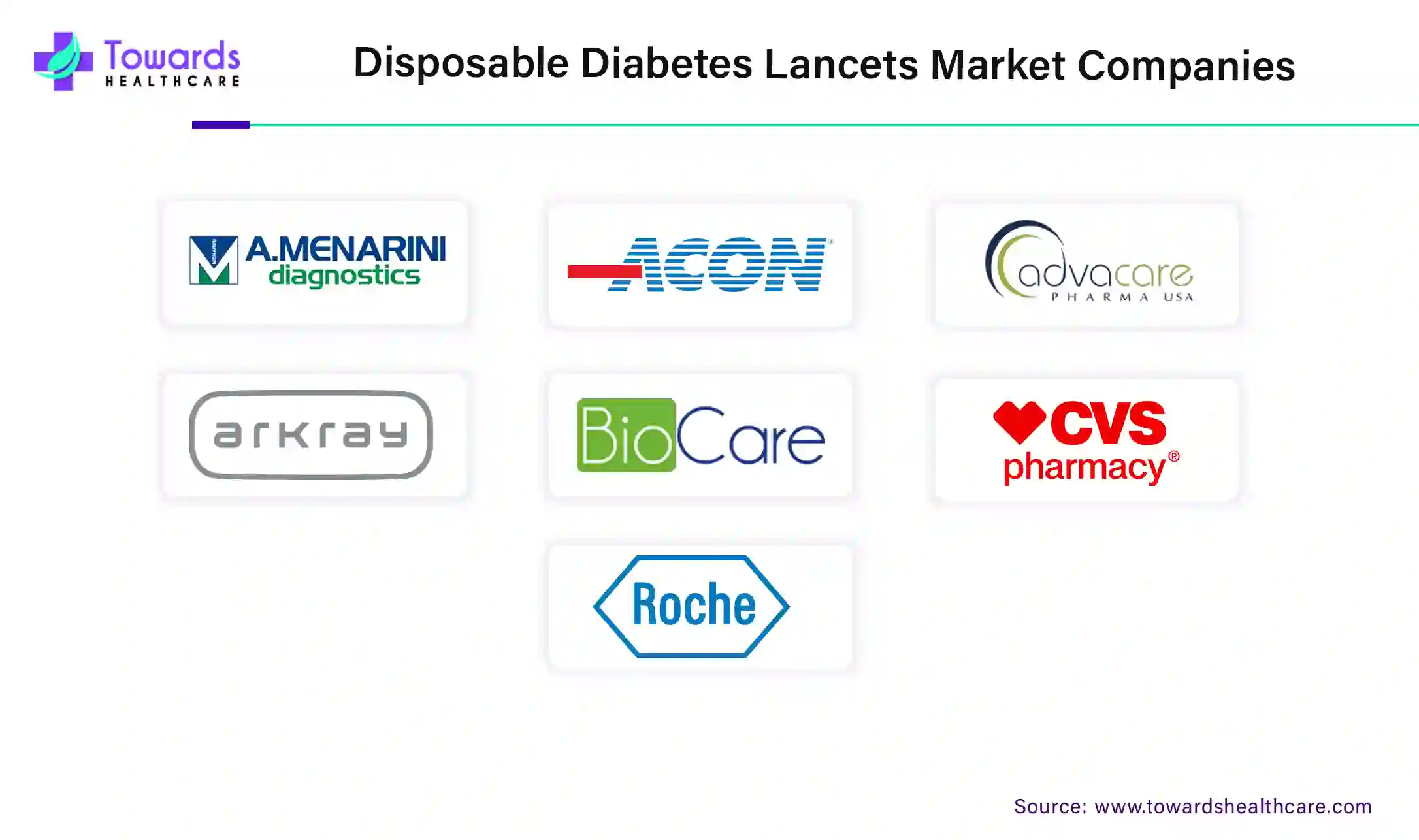November 2024


Principal Consultant

Reviewed By
The disposable diabetes lancets market size was estimated at US$ 1.19 billion in 2023 and is projected to grow to US$ 1.9 billion by 2034, rising at a compound annual growth rate (CAGR) of 4.33% from 2024 to 2034. The increasing demand for point-of-care diagnostics, the rising prevalence of diabetes, and technological advancements drive the market.

Lancets are sterile, sharp needles used to withdraw a minuscule amount of blood sample by pricking the skin of the finger. They are generally disposable, i.e. used only once. They are of two types: standard lancets and safety lancets. They are widely used in monitoring blood glucose in diabetic patients. The increasing demand for point-of-care diagnostics for blood glucose monitoring promotes the use of lancets.
The rising prevalence of both type I ae II diabetes mellitus requires frequent monitoring of blood glucose levels. The demand for lancets increases with the advent of the latest technologies like lancet devices. Lancet devices are small tubes that launch a small needle without causing pain to the patient.
Artificial intelligence (AI) and machine learning (ML) models have widespread use in diabetes management. The rising adoption of AI leads to novel advancements in digital health technologies, providing significant opportunities to achieve better efficiency in diabetes care. Integrating AI in diagnostic tools improves accuracy and precision, thereby minimizing errors. This will further increase the demand for diabetes diagnostics. AI can also help in identifying already used lancets, eliminating the risk of needlestick infections. Furthermore, AI can streamline the manufacturing process of disposable diabetes lancets, leading to reproducible results and faster production. Predictive analysis technology can predict potential errors in manufacturing facilitating timely decisions.
The increasing incidences of diabetes due to the increasing geriatric population, sedentary lifestyles, and hereditary is a major public health concern among individuals. It is estimated that more than half a billion people globally are living with diabetes, and it is estimated that by 2050, around 1.3 billion will be affected. The global prevalence is 6.1%, making it one of the top 10 leading causes of death and disability. The rising prevalence of diabetes necessitates frequent checking or regulation of blood sugar levels. The need for frequent checking raises the demand for point-of-care diagnostics, thereby increasing the demand for disposable diabetes lancets.
The rising demand for disposable diabetes lancets drives the latest innovations to improve the device’s capability. The rising prevalence of diabetes and the demand for painless blood withdrawal result in novel lancet designs. Some devices use lancets with a small diameter to deliver painless pricking. Some manufacturers have designed vacuum-assisted lancing devices that use vacuum before, during, and after lancing to accelerate blood withdrawal. Some lancing devices have multiple depth settings to suit different skin settings. The fear of self-pricking in many individuals is lowered with such advancements. Lancing devices with retractable needles significantly reduces pain, the fear of self-pricking, and the chances of needlestick injuries. They also maintain the sterility of the lancets. Another advancement in lancet design is high-speed needle propulsion. The lancet can prick the skin as soon as it touches the skin’s surface.
The major challenge of using a disposable diabetes lancet is the risk of needlestick injuries. Needlestick injuries are caused due to accidentally pricking the skin with a used needle. This could lead to the transmission of diseases like HIV, hepatitis B, and hepatitis C. Another major challenge is the demand for continuous glucose monitoring using a wearable device. A wearable device can track changes in blood glucose levels in real time, eliminating the use of conventional blood glucose monitoring devices.
North America held a dominant presence in the disposable diabetes lancets market in 2023. The rising prevalence of diabetes, technological advancements, demand for point-of-care diagnostics, and the presence of key players drive the market. Diabetes in the US is a major public health concern affecting approximately 37.3 million Americans or 11.3% of the total population.
In Canada, approximately 4.1 million people were diagnosed with both type 1 and type 2 diabetes in 2023 and it is estimated to rise to 5.1 million by 2033. The market is also driven by favorable government policies to support point-of-care diagnostics. The National Institute of Biomedical Imaging and Bioengineering supports point-of-care technology development that provides real-time medical evaluation and analysis of the disease status or condition at the time and place of patient care. They also provide research funding for the novel development of the device.
Asia-Pacific is anticipated to grow with the highest CAGR in the disposable diabetes lancets market during the studied years. The rising geriatric population, increasing prevalence of diabetes, technological advancements, rapidly growing healthcare infrastructure, and increasing investments & collaborations drive the market. Countries like China, India, and Pakistan have the highest number of diabetes cases in the world. China is the leading country with more than 141 million people living with diabetes. According to a new study published in The Lancet, it is estimated that 101 million people in India are living with diabetes, i.e. around 11.4% of the country’s population. In 2023, The Ministry of Health and Family Welfare, India launched an initiative of screening and placing 75 million people with hypertension or diabetes on Standard Care by 2025.
By type, the safety lancets segment is estimated to gain traction in the disposable diabetes lancets market in the upcoming years. Safety lancets are a safer alternative to standard lancets as they do not have the risk of needlestick injuries. They can puncture and penetrate to a predetermined depth, hence they are personalized to every patient type. Technological advancements and the latest innovations augment the segment’s growth.
By application, the hospital & clinic segment held the largest share of the disposable diabetes lancets market in 2023. The increasing number of patients for diabetes testing and suitable facilities for disposing of lancets boost the segment’s growth. Disposable diabetes lancets are widely used in hospitals & clinics as they have trained professionals, thereby reducing the chance of injury or infection.
Doug Shaver, President and CEO of ASP Global, commented on the acquisition of MediCore Medical Supply, that MediCore’s proprietary brand of blood collection products including safety lancets and heel sticks, marketed under the ReadyLance brand, will enhance the company’s value to hospitals and distribution customers.

By Type
By Application
By Region
November 2024
November 2024
December 2024
October 2024